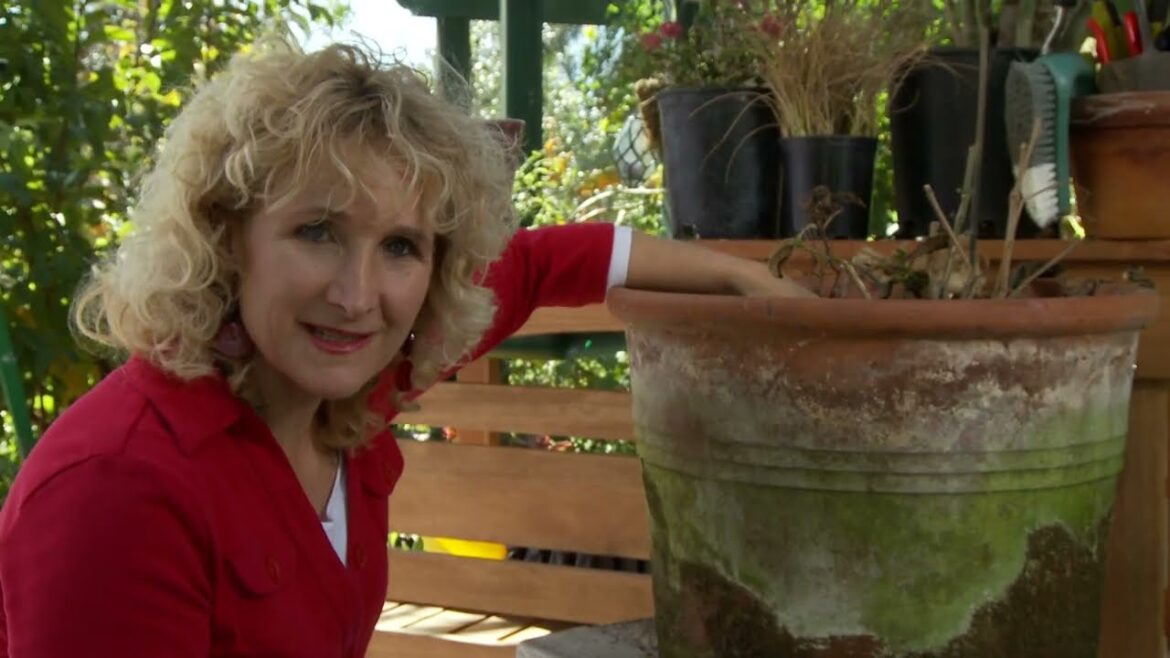In this episode of A Growing Passion, host Nan Sterman shares her expert tips for diagnosing and fixing the most common container garden problems.
From droopy leaves and dry soil to pests and nutrient issues, Nan shows how to bring struggling plants back to life. Learn how to spot early warning signs, refresh tired soil, and create the perfect balance of water, light, and fertilizer so your plants can thrive again.
People often ask me what’s wrong with their container plants. Container plants just need different kind of care than plants in the ground. So, for example, this poor guy is looking really, really sad. Well, this is why. It’s totally rootbound. What I would do for this grass is take a knife, slice him in quarters, rough up the roots, and put each quarter into a new, larger pot. It’ll grow back within a few months. it’ll look just fine. This Lantana is a landscape plant, and it’s the kind of plant that once you put it in the ground, it’ll just grow and grow and grow. When I’m looking at it now, there’s some holes in the leaves, which tells me something’s eating at it. Now, I could spray it, but really, that’s not what I want to do. Frankly, all I’m going to do is cut off the yucky leaves, put it in the ground, and wait for it to develop a whole new flesh of healthy leaves. This is a plectranthus that’s just way leggy. leggy, meaning these are long branches with just a little bit of leaves at the end. So, we’ll check out the roots first. Not too bad. It could it could go into a bigger pot, but it doesn’t have to. Instead, what I think I’ll do is I’ll cut it down to about this high. Maybe cut it back by half and take care of it. What’ll happen is it’ll get a whole new flush of leaves low um on those branches and it’ll be beautiful once again, just like it was originally. Now, this poor succulent was beautiful, but one night we had a frost on the patio and all the leaves at the top died back. The lower ones were protected, but the top ones died back. A lot of people would think better get out my pruning shears and cut off the frosted part. That is the last thing I’m going to do. I left it. And you can see that new leaves are sprouting every place there had been leaves before. Now, I’m just going to leave this for a few more months and it’ll respout completely. At that point, I’ll look at it and see if the branches look too leggy, if it needs to be cut back, but I’m guessing it’s going to be beautiful once again. Now, this pot has a lot of different things going on. For one thing, in the center is a plant that’s deciduous. It’s a hosta, so it goes away this time of year, and that’s expected. Then there’s these little crunchy plants. Well, these are not longived, and that’s okay. I can replace those. But then you’ve got a plant like this. This should have more leaves on it, and the leaves should look a lot better. but instead it’s got green leaves with brown edges which suggests salt burn. I’m not talking about like table salt. I’m talking about the calcium salts that are in hard water like we have in our region. And that’s confirmed by looking at the surface. See all this white stuff? That’s the calcium salts left over from watering. The water goes through, it evaporates and it leaves the calcium behind. And then I look at this green stuff which tells me I’ve been watering it too much. So, to fix this pot, what I need to do is to take everything out of it, refresh the potting soil, and put the plants back in. But first, I have to get all this stuff off. Now, the way to clean this off, one is I use my hand to tri and I scrape off as much as I can. And what’s left, I’m going to wet and then scrub with a brush. Watch what happens. Ah, there’s the terracotta. So, I’ll do that to the whole pot. Get my fresh soil inside, put my plants back in, and wait till spring when they’ll respout. It’s not hard to take care of container plants. You just have to use your powers of observation. The plants will tell you what they need. [Music]


Comments are closed.